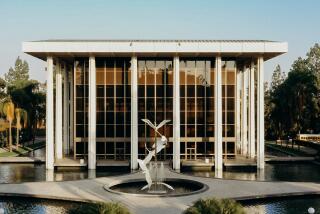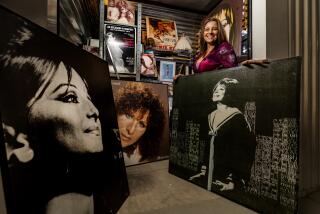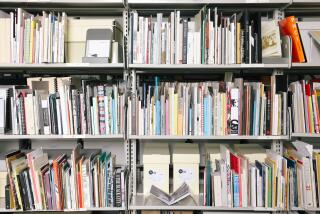KFAC Parcels Out Classical Library
- Share via
When KFAC--Los Angeles’ first and only commercial classical radio station--abandons its venerable format next month, its substantial collection of recordings will be parceled out to Stanford University, the Los Angeles Public Library, and to public radio station KUSC, station officials have disclosed.
The donation of the library serves as a virtual nail in the coffin for the classical station, assuring that KFAC (FM 92.3) will not remain classical as was promised when the station was bought by Evergreen Media Corp. in January for $55 million.
After reports that he was trying to sell the library and call letters for $1 million, KFAC president and general manager Jim de Castro said Tuesday that in late September he plans to donate the record portion of the station’s library--estimated at 50,000 recordings--to Stanford University and the station’s collection of 5,000 compact discs to the Los Angeles Public Library.
“We have come to terms and we’re delighted with opportunity of donating our library as opposed to selling our library,” De Castro said. “The reason we’re donating it is so the Los Angeles public will have the opportunity to . . . check it out at the public library at no cost.”
Said City Librarian Wyman Jones of the donation: “We are very pleased to receive this remarkable gift. It will be housed in our Central Library in downtown Los Angeles where it will be available for loan to the public.”
William Moran, honorary curator of Stanford University’s Archive of Recorded Music, said:”I think it’s absolutely tremendous.”
De Castro said he also plans to donate “some of the rarest and most unusual discs that they don’t already have” to public radio station KUSC-FM. He said he wants the donated records to be introduced as having been “brought to you by (KFAC owners) Evergreen Media Corp., who now programs FM-92.” FM-92 is what the station is now calling itself, in preparation for its switch to a pop music format.
He will also turn over the station’s call letters to one of the three stations licensed to USC. KUSC’s programming is currently simulcast on two other public stations (KSCA in Santa Barbara and KCPB in Ventura County). A fourth USC-owned station to serve the Palm Springs area is under construction.
KUSC General Manager Wally Smith said that KUSC’s call letters will remain the same, but that one of the satellite stations will pick up KFAC’s identifying letters.
A press conference on this subject is scheduled for today.
“I knew it was a very fragile and delicate thing to change the format because of the passion with which people regard the format,” De Castro said. “Economics have dictated that this change is necessary to make. . . . The minute we do switch over to a new format, while it will offend the classical listeners that are here, the minute we switch we will be delivering five times the audience at least and delivering much more of the type of sound that L.A. is requesting.”
Since its establishment in 1938, KFAC has been steadily acquiring recordings that have made it the nation’s third-largest classical radio station library. Occupying a cramped area in the station’s headquarters in Hollywood, the tightly stacked recordings are arranged by record label, with separate sections for opera, film scores and musicals.
“A lot of the strength of the library is how much non-great music there is by non-great artists,” says announcer John Santana.
Almost any music library, for instance, will house Beethoven’s Violin Concerto, but it isn’t easy to find a recording of symphonies by Bohemian composer Georg Anton Benda, half a dozen different performances of Gilbert and Sullivan’s “The Gondoliers” or a recording of Bach’s Toccata and Fugue in D minor performed by the Yale Accordion Symphony.
The option of donating the library loomed larger as KFAC was unable to sell its collection. When KKGO president Saul Levine announced his intent to change the format of his jazz station to predominantly classical last month, many observers believed that KKGO would purchase KFAC’s largely classical library. But Levine said he was not willing to pay the $1-million asking price.
De Castro said he was never seeking such a high figure, though he did say that two appraisers valued the collection at upwards of $1.8 million. He suggested that a station might be willing to pay about $2 apiece for the LPs, and considerably more for the CDs, and estimated the library’s market value to be somewhere between $125,000 and $500,000, if sold as a unit.
But whether the collection could be sold at all was open to question. Almost all of the recordings in the studio’s library were given to KFAC free for promotional purposes by the record companies. A spokesman for CBS records said that if KFAC were to sell the records, “they would be violating the conditions under which the records were given to them.”
Even if the collection were to be donated, recording distributors have voiced objections. Jerry Stein of Los Angeles-based Delta Music, noted, “KUSC already has every CD we have released,” and he fears that the discs may well end up in used-record stores. “We want (KFAC) to turn them over to KKGO,” he said, “or give them back to us.”
One resource that has apparently disappeared from the library is the potentially vast collection of taped interviews and special programs produced by KFAC. Current staff members cannot account for the materials.
Former announcer and host of “Luncheon at the Music Center” Thomas Cassidy said that he believes that most of the tapes of his noontime interviews were erased, but that he has copies of most of the old Philharmonic and Hollywood Bowl programs. Tom Dixon, who like Cassidy, worked for more than 40 years at KFAC and interviewed such artists as Carlo Maria Giulini and Beverly Sills, laments that he kept “precious few. . . . I could kick myself.”
Carl Princi, the station’s program director until 1985, still has “probably a couple hundred tapes,” but he said that these are copies, not the original tapes. “I would assume that the originals are non-existent,” he said.
The meat of collection, however, are the classical LPs and CDs. “Whether it’s worth any money or not really is beside the point,” says Bob Wennersten, KFAC’s program director. “It is the depth of this collection that is its real value.”
More to Read
Sign up for Essential California
The most important California stories and recommendations in your inbox every morning.
You may occasionally receive promotional content from the Los Angeles Times.













